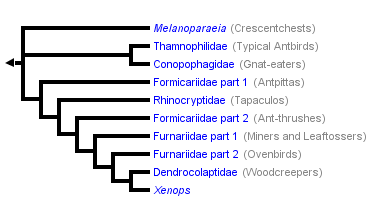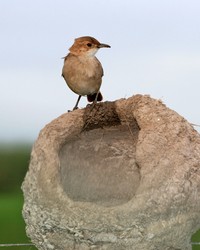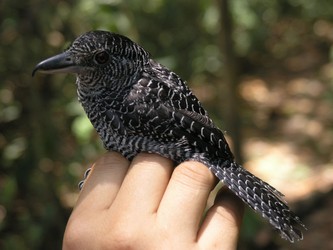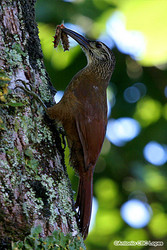Furnarii
John Harshman


This tree diagram shows the relationships between several groups of organisms.
The root of the current tree connects the organisms featured in this tree to their containing group and the rest of the Tree of Life. The basal branching point in the tree represents the ancestor of the other groups in the tree. This ancestor diversified over time into several descendent subgroups, which are represented as internal nodes and terminal taxa to the right.

You can click on the root to travel down the Tree of Life all the way to the root of all Life, and you can click on the names of descendent subgroups to travel up the Tree of Life all the way to individual species.
For more information on ToL tree formatting, please see Interpreting the Tree or Classification. To learn more about phylogenetic trees, please visit our Phylogenetic Biology pages.
close boxRelationships after Chesser (2004).
Discussion of Phylogenetic Relationships
There is a basal polytomy in Furnarii among three clades: Melanopareia (crescent-chests), a genus traditionally assigned to Rhinocryptidae (Irestedt et al. 2002; Chesser 2004), Thamnophilidae (typical antbirds) plus Conopophagidae (gnateaters), and remaining Furnarii (Irestedt et al. 2001, 2002; Chesser 2004; but see Barker et al. 2002, 2004 for a different placement of conopophagids). Thamnophilidae is a clade detached from Formicariidae (then just "antbirds") by Sibley and Ahlquist (1990). But even with thamnophilids removed, Formicariidae (ground antbirds) has proven to be paraphyletic. It is divided into two parts; one of them, ant-pittas, is apparently the sister group of the remaining Furnarii (though in some analyses it is the sister group of Rhinocryptidae, the tapaculos). The other part of Formicariidae, ant-thrushes, is sister to Furnariidae (ovenbirds) and Dendrocolaptidae (woodcreepers). (There is so far no formal name for either of these divisions of Formicariidae.) Furnariidae is paraphyletic to Dendrocolaptidae (Irestedt et al. 2002; Chesser 2004), and so is also divided into two groups, neither of which has a formal name. And there is a third group of Furnariidae, the odd genus Xenops, which is even closer to the woodcreepers (Irestedt et al. 2006). Nor are even the traditional antpittas monophyletic; one genus commonly assigned to the group, Pittasoma, turns out to be a gnateater (Rice 2005a, b).
References
Barker, F. K., G. F. Barrowclough, and J. G. Groth. 2002. A phylogenetic hypothesis for passerine birds; Taxonomic and biogeographic implications of an analysis of nuclear DNA sequence data. Proc. R. Soc. Lond. B 269:295-308.
Barker, F. K., A. Cibois, P. Schikler, J. Feinstein, and J. Cracraft. 2004. Phylogeny and diversification of the largest avian radiation. Proc. Natl. Acad. Sci. USA 101:11040-11045.
Chesser, R. T. 2004. Molecular systematics of New World suboscine birds. Mol. Phylogen. Evol. 32:11-24.
Feduccia, A. 1973. Evolutionary trends in the Neotropical ovenbirds and woodhewers. Ornithol. Monogr. 13:1?69.
Irestedt, M., J. Fjelds?, and P. G. P. Ericson. 2006. Evolution of the ovenbird-woodcreeper assemblage (Aves: Furnariidae) ? major shifts in nest architecture and adaptive radiation. Journal of Avian Biology 37:261?272.
Irestedt, M., J. Fjelds?, U. S. Johansson, and P. G. P. Ericson. 2002. Systematic relationships and biogeography of the tracheophone suboscines (Aves: Passeriformes). Mol. Phylogen. Evol. 23:499-512.
Irestedt, M., U. S. Johansson, T. J. Parsons, and P. G. P. Ericson. 2001. Phylogeny of major lineages of suboscines (Passeriformes) analysed by nuclear DNA sequence data. J. Avian Biol. 32:15-25.
Krabbe, N. K. and Schulenberg, T. S. 2003. Family Formicariidae (Ground-antbirds). Pages 682?731 in Handbook of the Birds of the World. Vol. 8. Broadbills to Tapaculos. BirdLife International and Lynx Editions, Cambridge, UK and Barcelona.
Rice, N. H. 2005a. Phylogenetic relationships of antpitta genera (Passeriformes: Formicariidae). Auk 122(2):673-683.
Rice, N. H. 2005b. Further Evidence for Paraphyly of the Formicariidae (Passeriformes). Condor 107(4):910-915.
Ridgely, R. S. and G. Tudor. 1994. The Birds of South America. Volume 2. The Suboscine Passerines. University of Texas, Austin.
Sibley, C. G., and J. A. Ahlquist. 1990. Phylogeny and classification of birds, Yale U. Press, New Haven.
Skutch, A. F. 1996. Antbirds and Ovenbirds. University of Texas Press, Austin, TX.
Tubaro, P. L., D. A. Lijtmaer, M. G. Palacios, and C. Kopuchian. 2002. Adaptive modification of tail structure in relation to body mass and buckling in woodcreepers. Condor 104(2):281-296.
Title Illustrations

| Scientific Name | Furnarius rufus |
|---|---|
| Location | Entre Rios, Argentina |
| Comments | on incomplete nest |
| Specimen Condition | Live Specimen |
| Source | Rufous Hornero (Furnarius rufus) on incomplete nest |
| Source Collection | Flickr |
| ToL Image Use |
 This media file is licensed under the Creative Commons Attribution-NonCommercial-NoDerivs License - Version 2.0. This media file is licensed under the Creative Commons Attribution-NonCommercial-NoDerivs License - Version 2.0.
|
| Copyright | © 2006 Lip Kee Yap |
| Scientific Name | Cymbilaimus lineatus |
|---|---|
| Location | Panama |
| Specimen Condition | Live Specimen |
| Source | Fasciated Antshrike |
| Source Collection | Flickr |
| ToL Image Use |
 This media file is licensed under the Creative Commons Attribution-NonCommercial-ShareAlike License - Version 2.0. This media file is licensed under the Creative Commons Attribution-NonCommercial-ShareAlike License - Version 2.0.
|
| Copyright | © 2006 joule_e |
| Scientific Name | Xiphorhynchus guttatus |
|---|---|
| Location | Petr?polis, Brasil |
| Specimen Condition | Live Specimen |
| Source | Arapa?u-de-garganta-amarela |
| Source Collection | Flickr |
| ToL Image Use |
 This media file is licensed under the Creative Commons Attribution-NonCommercial-NoDerivs License - Version 2.0. This media file is licensed under the Creative Commons Attribution-NonCommercial-NoDerivs License - Version 2.0.
|
| Copyright | © 2006 Antonio CBC Lopes |
About This Page
Correspondence regarding this page should be directed to John Harshman at
Page copyright © 2006
 Page: Tree of Life
Furnarii.
Authored by
John Harshman.
The TEXT of this page is licensed under the
Creative Commons Attribution-NonCommercial License - Version 3.0. Note that images and other media
featured on this page are each governed by their own license, and they may or may not be available
for reuse. Click on an image or a media link to access the media data window, which provides the
relevant licensing information. For the general terms and conditions of ToL material reuse and
redistribution, please see the Tree of Life Copyright
Policies.
Page: Tree of Life
Furnarii.
Authored by
John Harshman.
The TEXT of this page is licensed under the
Creative Commons Attribution-NonCommercial License - Version 3.0. Note that images and other media
featured on this page are each governed by their own license, and they may or may not be available
for reuse. Click on an image or a media link to access the media data window, which provides the
relevant licensing information. For the general terms and conditions of ToL material reuse and
redistribution, please see the Tree of Life Copyright
Policies.
- First online 02 August 2006
- Content changed 05 December 2007
Citing this page:
Harshman, John. 2007. Furnarii. Version 05 December 2007 (under construction). http://tolweb.org/Furnarii/67980/2007.12.05 in The Tree of Life Web Project, http://tolweb.org/












 Go to quick links
Go to quick search
Go to navigation for this section of the ToL site
Go to detailed links for the ToL site
Go to quick links
Go to quick search
Go to navigation for this section of the ToL site
Go to detailed links for the ToL site